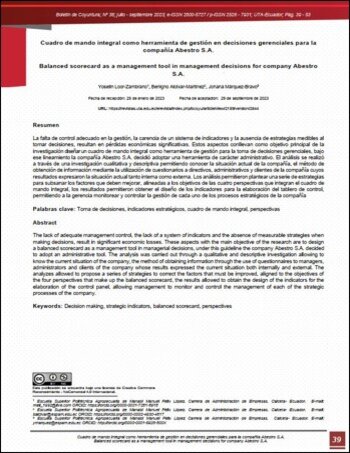Cuadro de mando integral como herramienta de gestión en decisiones gerenciales para la compañía Abestro S.A.
Contenido principal del artículo
Resumen
La falta de control adecuado en la gestión, la carencia de un sistema de indicadores y la ausencia de estrategias medibles al tomar decisiones, resultan en pérdidas económicas significativas. Estos aspectos con lleva como objetivo principal de la investigación diseñar un cuadro de mando integral como herramienta de gestión para la toma de decisiones gerenciales, bajo ese lineamiento la compañía ABESTRO S.A. decidió adoptar una herramienta de carácter administrativo. El análisis se realizó a través de una investigación cualitativa y descriptiva permitiendo conocer la situación actual de la compañía, el método de obtención de información mediante la utilización de cuestionarios a directivos, administrativos y clientes de la compañía cuyos resultados expresaron la situación actual tanto interna como externa. Los análisis permitieron plantear una serie de estrategias para subsanar los factores que deben mejorar, alineadas a los objetivos de las cuatro perspectivas que integran el cuadro de mando integral, los resultados permitieron obtener el diseño de los indicadores para la elaboración del tablero de control, permitiendo a la gerencia monitorear y controlar la gestión de cada uno de los procesos estratégicos de la compañía.
URL: https://revistas.uta.edu.ec/erevista/index.php/bcoyu/article/view/2189
Descargas
Detalles del artículo

Esta obra está bajo una licencia internacional Creative Commons Atribución-NoComercial 4.0.
![]()
Las publicaciones del Boletín de Coyuntura están bajo una licencia de Creative Commons Reconocimiento-NoComercial 4.0 Internacional (CC BY-NC 4.0). La Universidad Técnica de Ambato conserva los derechos patrimoniales (copyright) de las obras publicadas, y favorece y permite la reutilización de estas, siempre que: se cite la autoría y fuente original de su publicación, no se usen para fines comerciales u onerosos. La propiedad intelectual de los artículos publicados pertenece a los autores de los mismos.
Citas
Alcívar, B. J., María Judith Carranza-Anzules, & Y. J. Márquez-Bravo. (2023). Evaluación de la motivación y la satisfacción laboral en la cooperativa ahorro-crédito lucha campesina. PURIQ. https://doi.org/10.37073/puriq.5.492
Alcívar, B. J., Bravo, J. M., Avellán, I. J. R., & Garcés, Y. J. Z. (2021). Diagnóstico al fomento de la economía popular y solidaria realizada en las cadenas supermercados grandes y medianas de la ciudad de Calceta. Boletín de Coyuntura, 28, 32–42. https://doi.org/10.31243/bcoyu.28.2021.1067
Acuacultura. (2021). La Industria Camaronera Ecuatoriana y sus Oportunidades de Mercado. Revista Acuacultura – Cámara Nacional de Acuacultura # 139. Ed. 143. 8- 104. https://www.cna-ecuador.com/revista-acuacultura/
Bolaños Jijón, A. F., Méndez Bravo, J. C., & Méndez Bravo, M. (2020). Balanced Scorecard como Herramienta de Gestión y mejora en los Emprendimientos. INNOVA Research Journal, 5(3), 62-77. https://doi.org/10.33890/innova.v5.n3.2020.1362
Durán Velásquez, L. (2018). Estrategia de gestión basada en el cuadro de mando integral para la empresa herrametal C.A. ubicada en municipio Iribarren, Estado Lara. Enfoque Disciplinario, 3(1), 49-71. Recuperado a partir de https://enfoquedisciplinario.org/revista/index.php/enfoque/article/view/12
Fedexpor. (2022). Reporte Estadístico de Comercio Exterior. EXPORdata, 1-18. Obtenido de https://www.fedexpor.com/inteligencia-comercial/reporte-expordata/
Ghiglione, Franco Alexis. (2021). El cuadro de mando integral como herramienta de eficiencia en la gestión empresarial. Ciencias administrativas, (18) ,87 93. https://dx.doi.org/https://doi.org/10.24215/23143738e088
Jiménez Cueva, B. M., Erazo Álvarez, J. C., Narváez Zurita, C. I., & Quevedo Vázquez, J. O. (2019). El balanced scorecard como herramienta de gestión para mejorar la productividad de la industria camaronera: Caso camaronera Biocultivos del Mar (Biomar) Cía. Ltda. Visionario Digital, 3(2.2), 81-102. https://doi.org/10.33262/visionariodigital.v3i2.2.617
Kaplan, R. S. y Norton, D. P. (2000). The Strategy-Focused Organization: How Balanced Scorecard Companies Thrive in the New Business Environment. Harvard Business School Press.
Loayza Galarza, C., Pastor Toala, J., Salcedo Muñoz, V. E., & Sotomayor Pereira, J. (2022a). Efecto covid-19 en las determinantes de las exportaciones del sector camaronero del Ecuador, año 2020. ECA Sinergia, 13(1), 21.
Malpica Mujica, M. M. (2021). Evaluación del uso de planes estratégicos basados en la aplicación del cuadro de mando integral como herramienta de control administrativo para optimizar la gestión financiera. Caso: industrias celta, s. A. Business Innova Sciences, 2(3). Recuperado a partir de https://www.innovasciencesbusiness.org/index.php/ISB/article/view/53
Martínez, J. (2022). Aplicación del Cuadro de Mando Integral en Feltwood Ecomateriales. [Trabajo de grado. Universidad Zaragoza]. https://core.ac.uk/reader/521879780
Méndez Bravo, J. C., Ayala Briones, H. J., & Palacios Sarmiento, T. Y. (2019). El Balanced Scorecard en el Desarrollo de los Negocios Familiares. INNOVA Research Journal, 4(3), 94-107. https://doi.org/10.33890/innova.v4.n3.2019.963
Müller, J. (2019). Herramientas de Control de Gestión en Pequeñas y Medianas Empresas en Chile. CAPIC Review, Journal Of Accounting, Auditing And Business Management. 4(17), 1-14 DOI: https://doi.org/10.35928/cr.vol17.2019.72
Ollague, J., Ramón, D. y Soto, C. (2017). Indicadores financieros de gestión: análisis e interpretación desde una visión retrospectiva y prospectiva. Innova Research journal, 2 (8.1), 22-41. DOI: https://doi.org/10.33890/innova.v2.n8.1.2017.328
Quintero-Beltrán, L., & Osorio-Morales, L. (2018). Balanced scorecard como herramienta para empresas en estado de crisis. Revista CEA, 4(8), 75-94. https://doi.org/10.22430/24223182.1049
Trasmonte-Rosendo, P. R. (2021). Indicadores de gestión aplicando el modelo de cuadro de mando integral. Gestio Et Productio. Revista Electrónica De Ciencias Gerenciales, 3(4) ,34-49.Recuperadoapartirde https://iieakoinonia.org/ojs3/index.php/gestioep/article/view/27


